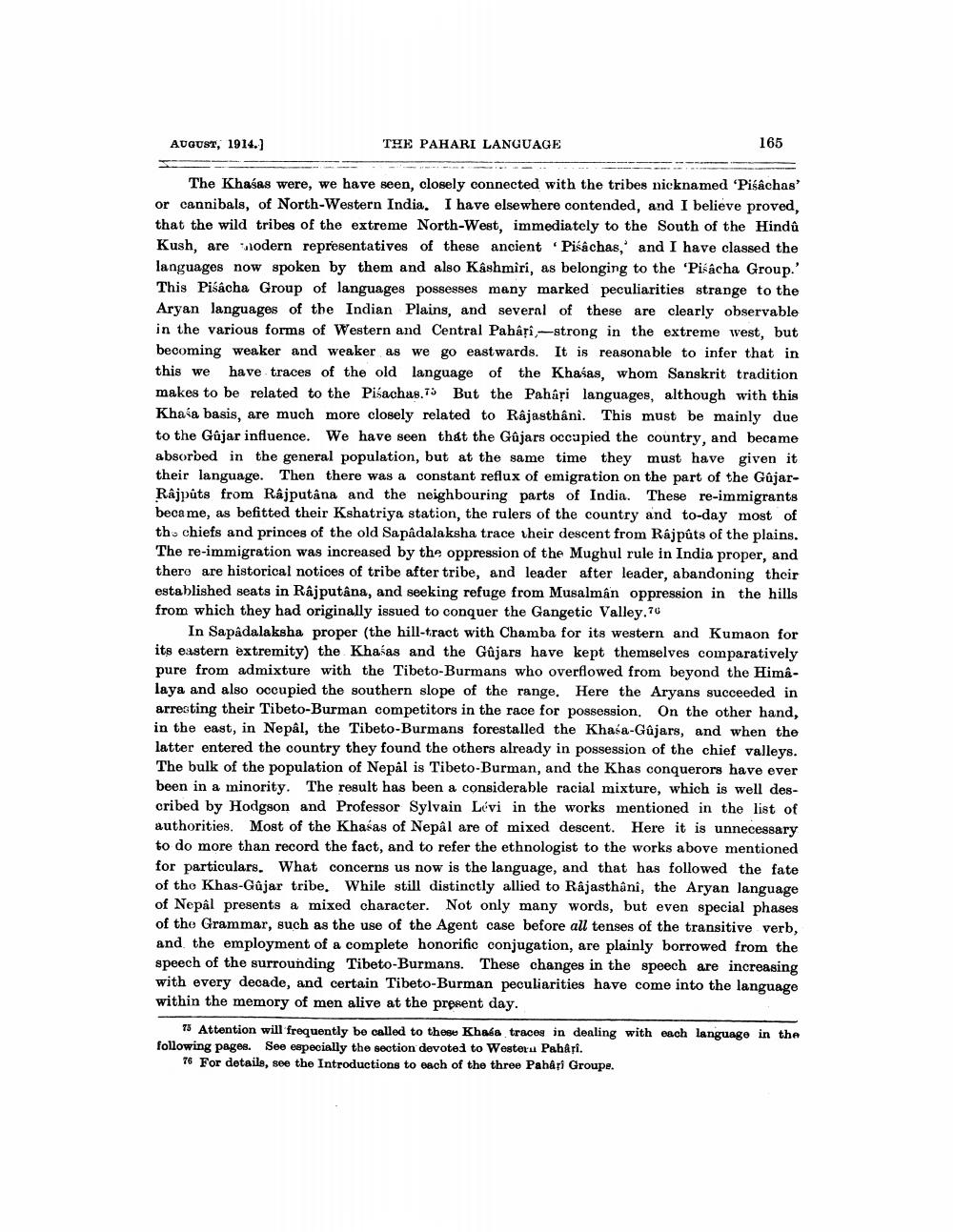________________
AUGUST, 1914.]
THE PAHARI LANGUAGE
165
The Khaśas were, we have seen, closely connected with the tribes nicknamed 'Piśâchas' or cannibals, of North-Western India. I have elsewhere contended, and I believe proved, that the wild tribes of the extreme North-West, immediately to the South of the Hindu Kush, are modern representatives of these ancient Pisachas, and I have classed the languages now spoken by them and also Kashmiri, as belonging to the 'Pisacha Group.' This Pisacha Group of languages possesses many marked peculiarities strange to the Aryan languages of the Indian Plains, and several of these are clearly observable in the various forms of Western and Central Pahârî-strong in the extreme west, but becoming weaker and weaker as we go eastwards. It is reasonable to infer that in this we have traces of the old language of the Khasas, whom Sanskrit tradition makes to be related to the Pisachas.75 But the Pahari languages, although with this Khasa basis, are much more closely related to Rajasthâni. This must be mainly due to the Gûjar influence. We have seen that the Gûjars occupied the country, and became absorbed in the general population, but at the same time they must have given it their language. Then there was a constant reflux of emigration on the part of the GujarRajputs from Rajputâna and the neighbouring parts of India. These re-immigrants became, as befitted their Kshatriya station, the rulers of the country and to-day most of the chiefs and princes of the old Sapâdalaksha trace their descent from Rájpûts of the plains. The re-immigration was increased by the oppression of the Mughul rule in India proper, and there are historical notices of tribe after tribe, and leader after leader, abandoning their established seats in Râjputâna, and seeking refuge from Musalman oppression in the hills from which they had originally issued to conquer the Gangetic Valley.76
In Sapâdalaksha proper (the hill-tract with Chamba for its western and Kumaon for its eastern extremity) the Khasas and the Gûjars have kept themselves comparatively pure from admixture with the Tibeto-Burmans who overflowed from beyond the Himâlaya and also occupied the southern slope of the range. Here the Aryans succeeded in arresting their Tibeto-Burman competitors in the race for possession. On the other hand, in the east, in Nepâl, the Tibeto-Burmans forestalled the Khasa-Gûjars, and when the latter entered the country they found the others already in possession of the chief valleys. The bulk of the population of Nepal is Tibeto-Burman, and the Khas conquerors have ever been in a minority. The result has been a considerable racial mixture, which is well described by Hodgson and Professor Sylvain Lévi in the works mentioned in the list of authorities. Most of the Khasas of Nepâl are of mixed descent. Here it is unnecessary to do more than record the fact, and to refer the ethnologist to the works above mentioned for particulars. What concerns us now is the language, and that has followed the fate of the Khas-Gûjar tribe. While still distinctly allied to Rajasthani, the Aryan language of Nepal presents a mixed character. Not only many words, but even special phases of the Grammar, such as the use of the Agent case before all tenses of the transitive verb, and the employment of a complete honorific conjugation, are plainly borrowed from the speech of the surrounding Tibeto-Burmans. These changes in the speech are increasing with every decade, and certain Tibeto-Burman peculiarities have come into the language within the memory of men alive at the present day.
75 Attention will frequently be called to these Khasa traces in dealing with each language in the following pages. See especially the section devoted to Western Pahârî.
76 For details, see the Introductions to each of the three Pahari Groupe.




